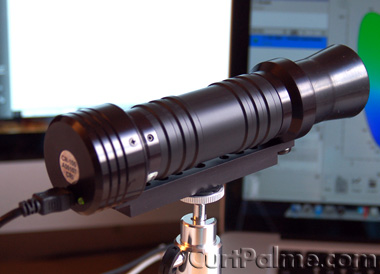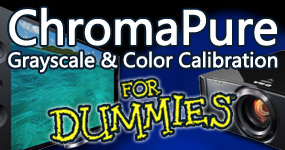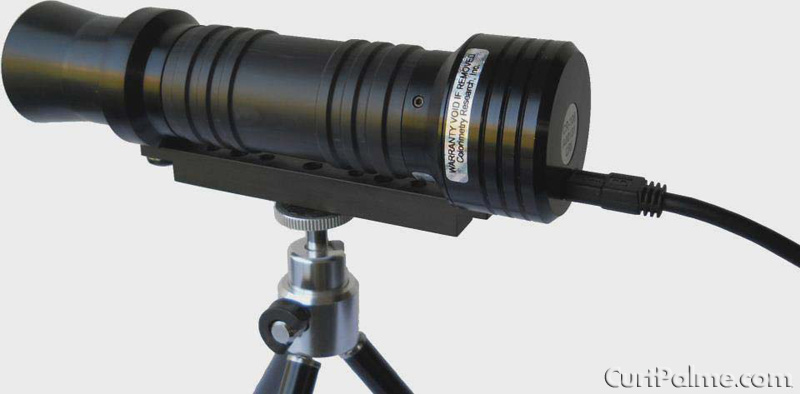
|
Questions?
Contact us.
|

Colorimetry Research CR‑100 Professional Colorimeter
(ChromaPure software not
included) |
|
|
|

Colorimetry Research CR‑100 Professional Colorimeter
with ChromaPure
Professional
ChromaPure info
|
|
|
|
|
ADD-ONS:
|
ADD-ON: Calibrated cosine
receptor/
diffuser
For
reading directly from a
projector lens (not
normally required or
recommended).
Must be
purchased at the same
time as a CR-100. |
|
|
|
ADD-ON: Long reach meter mount extension bar
Use if your tripod is obstructing the meter from getting close to the target measurement area.
Must be
purchased at the same
time as a CR-100. |
|
|
|
|
Contact us if interested
in other add-ons, or for custom orders.
Sign up
today to receive the latest CR-100 and ChromaPure news.
Most US orders ship USPS Priority Mail
and international orders ship USPS Express Mail. International orders may include extra import
duties and/or taxes according to the laws of the target country.
Contact us for custom shipping.
Payment methods include PayPal and all major credit cards
(PayPal account *not* needed to pay by credit card).
Our payment processor
will automatically convert the
amount
to
your local currency. Given the nature of calibration software/hardware,
all sales are final.
Orders ship directly from
the manufacturer.
|
New to calibration? Give our
free step by step guide a read:

Confused about meters? See our
FAQ: Which meter
is right for me?
The CR-100 is the most affordable professional colorimeter available. Just
mount on a tripod, facing towards the source, connect to
ChromaPure Professional, and then use as you would
any other color analyzer.
There are two colour analyzers that professionals and dedicated enthusiasts
generally seek: A professional quality colorimeter for every day work (the
"field" meter) and a reference spectroradiometer to keep the colorimeter
accurate (the "reference" meter).
Unfortunately, such devices are not cheap. The Photo Research and Minolta
reference spectros start at about $15,000 USD and go up to near $30,000 USD. The
Klein
K-10a, previously the only professional quality colorimeter on the market,
retails at $7,000 USD.
There is a new entry to the professional colorimeter on the market, the
Colorimetry Research CR-100.
In our testing of the CR-100 we have found that it performs at least as well,
and with respect at least to repeatability even better, than the Klein
instrument. It does this at a significantly lower price point of $4995 USD.
The CR-100 is accurate enough to be used as a standalone color analyzer for
professional applications. For the most demanding applications it can be
profiled against a true reference spectroradiometer (such as the
JETI 1211).
Either way, its speed, low-light sensitivity, and repeatability are world-class.
Professionals interested in CR-100 are usually comparing it to the
Klein K-10a as the two
units are similar in form and function (both are professional quality
colorimeters). The K-10a is faster than the CR-100, but not by a lot. Both
are similar in terms of accuracy. The K-10a is larger and includes a diffuser
and an aiming mechanism, although at a higher price. These features are
available for the CR-100 but as optional add-ons, bringing the pricing between
the two units closer.
Design
The all metal design is rugged and practical. What is likely to surprise most
people seeing the instrument for the first time is how small it is. Resembling a
telescopic sight, it is only 7 inches long, 1.5 inches in diameter, and weighs
less than a pound.
The CR-100 connects to a PC via USB, which also provides the necessary power.
The data interface is rs-232, which operates over the USB connection using an
internal usb/serial adapter and an in-house virtual COM port driver. It also
includes a tripod mount with several mounting slots for placement flexibility.
The FOV is quite narrow. For example, when placed one meter from the target
the spot size is only 4.3 inches (110 mm) in diameter. Since the instrument has
no aiming mechanism this is a useful design choice. Given its small size and
narrow FOV, most will find it quite easy to get a good aim point merely by line
of sight. Colorimetry Research also offers the CR-200, a version of the CR-100
with a configurable viewing port, but this adds another 15-20% to the price.
A calibrated cosine receptor/diffuser is available at additional cost. Some
may find this useful, but frankly the low-light sensitivity of the instrument is
so good (more about this below) that having the ability to read directly from a
projector lens would provide limited utility.
The colorimeter ships in a padded bag with a usb cable. The company's own
in-house software is available as well, though most will probably opt for custom
software, such as ChromaPure (which provides
support as of version 2.5.4).
There are three internal operating modes related to refresh rate detection
and synchronization. The meter's sync feature can be turned off, entered
manually, or set automatically when pointed at a 100% white test pattern
displayed on the target display device. This is a particularly useful feature
and no doubt contributes to the instrument's excellent repeatability, even at
very low light levels.
Performance
The performance of a color analyzer is a function of four measurable
criteria:
- Colorimetric accuracy
- Repeatability
- Low-light sensitivity
- Speed
Let's take a look at the CR-100 in each of these areas:
Colorimetric accuracy
We used the CR-100 to measure 8 displays using 4 different display
technologies (LED, LCD, CRT, and plasma) in our lab and then compared the
results with our JETI 1211 in-house
reference spectroradiometer:
|
|
White |
Red |
Green |
Blue |
|
Largest error (x,y) |
0.006 |
0.004 |
0.005 |
0.005 |
|
Smallest error (x,y) |
0.000 |
0.000 |
0.000 |
0.000 |
|
Average error (x,y) |
0.002 |
0.002 |
0.002 |
0.002 |
These are near reference results. Only the most exacting
applications would require correction with a reference instrument.
Colorimetry Research provides several built-in color correction matrices for
different display types.
Repeatability
Measuring a plasma display with the CR-100 set to automatically detect and
synchronize readings with the display's refresh rate (59.94 Hz), we obtained the
following results after 15 consecutive measurements:
|
|
x |
y |
Y |
|
Video black |
n/a |
n/a |
± 2.0% |
|
5% video |
± 0.0012 |
± 0.0011 |
± 1.39% |
|
10% video |
±
0.0003 |
±
0.0004 |
± 0.40% |
|
20% video |
± 0.0002 |
±
0.0004 |
±
0.13% |
Again, these are reference results. Clearly, the sync feature works very
well.
Low-light sensitivity
The ability to accurately and quickly read very low light levels is perhaps
the most attractive feature of tristimulus filter-based colorimeters. It is also
one of the most difficult features to test. More often than not, the
instrument's performance exceeds the precision of the display technology used
for the test and you end up measuring the limitations of the display rather than
the measuring tool.
For example, we first attempted to use the CR-100 to measure video black on a
Pioneer Kuro 9th-generation 5020 plasma, which is renowned for its unmeasureably
low black level. We soon discovered that the display's black level was not
stable (it may have been at one time, but after daily use for several years its
performance may have degraded). In fact, after receiving only a video black
signal the Kuro's output took several seconds to settle down, and then would
rather quickly go completely black. However, we got consistent, repeatable
readings of 0.0014 cd/m2 before the screen went black. In frustration, we tried
the same experiment with a JVC front projector, also known for its very low
black levels. However, in this case the test was compromised by the tiniest
amount of light in the room, such as our laptop monitor, which would elevate the
luminance reading off the screen (which is, after all, designed to reflect light
efficiently). Lacking the patience to turn the projector room into a black hole,
we decided to go with the stable, though fleeting, Kuro reading of 0.0014 cd/m2.
Throughout all of our tests we never encountered a signal so low that the
CR-100 could not reliably measure it. Whatever its merits as a colorimeter, the
CR-100 is also undoubtedly a world-class photometer, significantly outperforming
what used to be the gold standard in this area, the Minolta LS-100.
Speed
To test the speed of the CR-100, we generated an automated suite of 100 test
patterns from an AccuPel DVG-5000
that ChromaPure would read and then record.
We also ran this test against the popular
X-Rite i1Display Pro / i1Display Pro
Plus (aka Display 3)
and the Klein K-10a for purposes of comparison. In addition, we ran through one
pass of the the Lumagen Radiance 125-point
auto-calibration using each colorimeter to provide some-real world comparisons
and then extrapolated the time required for a 729-point and a 4913-point
auto-calibration:
|
Auto-calibration points |
Display 3 |
K-10a |
CR-100 |
|
125 |
6 minutes |
3 minutes |
3 minutes |
|
729 |
28 minutes |
13 minutes |
13 minutes |
|
4913 |
194 minutes |
90 minutes |
90 minutes |
Times include only the time required for the auto-calibration to complete.
Pre/post-calibration test patterns and grayscale/gamma calibration is not
included. Note that the Display 3 can run faster by setting the meter to a
shorter integration time, but doing so compromises repeatability.
The most interesting aspect of this comparison to us is that the speed of the
K-10a and the CR-100 were essentially identical. A display test pattern-return
reading cycle requires about 0.6 seconds for each colorimeter. This suggests
that the speed of each instrument is limited not by the instrument itself, but
by the rs-232 interface both use.
Among color analyzers, the K-10a has always been the speed champion. The
CR-100 is not faster than the K-10a, but it is obviously no slower. The speed of
a colorimeter used to be merely a matter of convenience, but with the advent of
popular and affordable options for auto-calibrations requiring hundreds or even
thousands of measurements, the speed of the measuring device becomes a much more
important factor.
Summary
As you can probably tell we were immensely impressed with the CR-100. It
achieves a combination of performance milestones that place it at the zenith of
commercially available professional colorimeters.
We do have a few minor quibbles. Installing the driver in Windows 8 is an
annoyance because the driver is unsigned. However, Colorimetry Research is
working on this issue and may have fixed the problem since this text was
written. Also, although it costs less than its only real competition (the
Klein
K-10a) the cost of adding an aiming device and a cosine receptor (the K-10a
includes both) all but eliminates the price advantage. Finally, as long as we
are picking nits we would have preferred a carrying case over a padded bag and a
longer USB cable.
However, when it comes to performance we cannot find any reason to criticize
the CR-100. It is the best professional-quality instrument to come along in
several years.
Specifications
|
|
Colorimetry Research CR-100 |
|
Wavelength range: |
380–780 nm |
|
Luminance Range: |
0.0002 fL to 1500 fL
0.0002 fL @ Signal to Noise Ratio > 10, 20 seconds
exposure
0.001 fL @ Signal to Noise Ratio > 10, 0.5 second
exposure
0.001 fL @ Signal to Noise Ratio > 100, 20 seconds
exposure
1500 fL @ Signal to Noise Ratio > 8000, 1 second exposure |
|
Luminance Accuracy: |
± 2 % @ 0.1 fL, 0.4 second exposure |
|
Luminance Repeatability: |
0.2 % @ 0.1 fL, 0.4 second exposure
1.5 % @ 0.01 fL, 0.5 second exposure
1.5 % @ 0.001 fL, 20 seconds exposure |
|
Chromaticity Accuracy: |
± 0.0015 x, y @ 0.1 fL, 0.4 second exposure
± 0.0015 x, y @ 0.02 fL, 20 seconds exposure |
|
Chromaticity Repeatability: |
0.0005 x, y @ 0.1 fL, 0.4 second exposure
0.0005 x, y @ 0.02 fL, 20 seconds exposure |
|
Polarization error: |
≤ 0.1 % |
|
Synchronization frequencies: |
10 - 500 Hz (Custom Synchronization from 10 Hz to 10 KHz
available) |
|
Exposure Time Range: |
1 ms to 20 seconds |
|
Power Requirements: |
5V, 120 mA (600 mW) via USB 2.0 |
|
Interface: |
USB 2.0, Ethernet |
|
Weight / Mass: |
12oz. (0.34 Kg.) |
Calibrating Front Projectors
For best accuracy, we recommend calibrating front projectors by taking
readings directly off the screen.
Extras included
- Padded bag
- USB Cable
- Universal mounting bar
- Wrist strap and bracket
Calibration DVD For your convenience our ChromaPure
partner offers a simple calibration DVD that includes all of the test patterns
that you'll need to perform a complete calibration of your display. This DVD is
offered free as a complementary download.
Click here to download the DVD
Instructions:
- Download the .zip file to your PC.
- Unzip the contents, which is an .iso DVD image file, to
your hard drive.
- Double-click the .iso file.
- If you have DVD burning software (e.g., Nero Burning
ROM), the file will open.
Set the image type to DVD (not CD) if necessary.
- Insert a blank, writable DVD into your DVD burner, and
then burn the image.
Pictures



Reviews/Testimonials
For reviews/testimonials of ChromaPure calibration software & packages, see our
ChromaPure order page.
Why buy from CurtPalme.com?
CurtPalme.com are calibration experts and authors of the popular
free calibration guide:
Grayscale & Color
Calibration for Dummies. We live and breathe calibration. No matter what
your needs we can assist in choosing what's right for you. We offer products for
the budget DIY'er all the way up to the seasoned professional, all at CurtPalme.com
discounted prices.
Links
ChromaPure software
ChromaPure
Grayscale & Color Calibration for Dummies
Official Colorimetry Research CR-100 Professional Colorimeter forum thread
ChromaPure Discussion/Support Forum
FAQ: Which meter
is right for me?
Colour
Science: About Meter Accuracy
Colour Science:
Video Calibration Myths
Questions, comments or feedback should be directed to
:
chromapure@curtpalme.com
|






